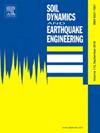近断层脉状地震动作用下斜坡场地的地震反应
IF 4.2
2区 工程技术
Q1 ENGINEERING, GEOLOGICAL
引用次数: 0
摘要
斜坡场地极易受到强烈的地面运动的影响,这可能会导致横向扩散,在极端情况下,还会导致流动破坏。本研究探讨近断层脉状(NF-P)地震动作用下斜坡场地的地震行为。利用多屈服面塑性本构模型,建立了倾斜场地的二维有限元模型,并用离心试验数据进行了验证。利用验证后的模型分析了NF-P和近断层非脉冲(NF-NP)地震动作用下土体的孔隙压力比、加速度响应、峰值剪切应变和侧向位移。结果表明,在高强度水平下,NF-P地面运动诱发松散砂层更严重的液化,加剧剪切变形,峰值剪切应变增加43.18%。液化松散砂层在减轻NF-P地面运动的影响方面效果较差,导致地表峰值加速度持续较高。此外,在NF-P地面运动下,斜坡场地的横向位移显著增加,横向位移增加了150%。与NF-NP地震动相比,NF-P地震动引起的横向位移和竖向位移也明显更大,横向位移达到0.97 m,土壤最大沉降和最大隆升分别是NF-NP地震动的2.67倍和2.60倍。本文章由计算机程序翻译,如有差异,请以英文原文为准。
Seismic response of sloping sites subject to near-fault pulse-like ground motions
Sloping sites are highly vulnerable to strong ground motions, which can induce lateral spreading and, in extreme cases, flow failure. This study investigates the seismic behavior of sloping sites subjected to Near-fault pulse-like (NF-P) ground motions. A two-dimensional finite element model of a sloping site was developed, utilizing a multiple yield surface plasticity constitutive model, which was validated with centrifuge test data. The validated model was then employed to analyze the pore pressure ratio, acceleration response, peak shear strain, and lateral displacement of soil subjected to both NF-P and Near-fault non-pulse (NF-NP) ground motions. The results demonstrate that, at high intensity levels, NF-P ground motions induce more severe liquefaction in loose sand layers, exacerbating shear deformations, as evidenced by a 43.18 % increase in peak shear strain. Liquefied loose sand layers are less effective at mitigating the effects of NF-P ground motions, resulting in persistently high peak accelerations at the surface. Furthermore, sloping sites experience substantially greater lateral displacements under NF-P ground motions, with lateral spreading displacement increasing by 150 %. NF-P ground motions also cause significantly larger lateral and vertical displacements compared to NF-NP ground motions, with lateral displacements reaching 0.97 m, and the soil maximum settlement and uplift being 2.67 and 2.60 times greater, respectively.
求助全文
通过发布文献求助,成功后即可免费获取论文全文。
去求助
来源期刊

Soil Dynamics and Earthquake Engineering
工程技术-地球科学综合
CiteScore
7.50
自引率
15.00%
发文量
446
审稿时长
8 months
期刊介绍:
The journal aims to encourage and enhance the role of mechanics and other disciplines as they relate to earthquake engineering by providing opportunities for the publication of the work of applied mathematicians, engineers and other applied scientists involved in solving problems closely related to the field of earthquake engineering and geotechnical earthquake engineering.
Emphasis is placed on new concepts and techniques, but case histories will also be published if they enhance the presentation and understanding of new technical concepts.
 求助内容:
求助内容: 应助结果提醒方式:
应助结果提醒方式:


